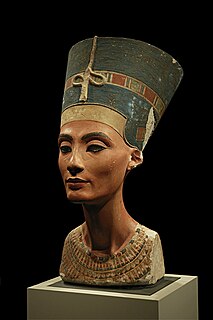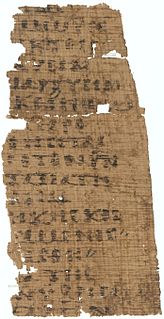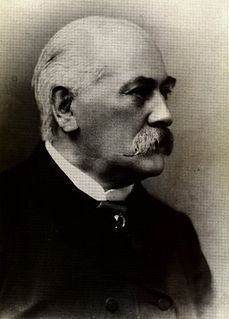
Papyrus is a material similar to thick paper that was used in ancient times as a writing surface. It was made from the pith of the papyrus plant, Cyperus papyrus, a wetland sedge. Papyrus can also refer to a document written on sheets of such material, joined together side by side and rolled up into a scroll, an early form of a book.

The Ebers Papyrus, also known as Papyrus Ebers, is an Egyptian medical papyrus of herbal knowledge dating to circa 1550 BC. Among the oldest and most important medical papyri of ancient Egypt, it was purchased at Luxor (Thebes) in the winter of 1873–74 by Georg Ebers. It is currently kept at the library of the University of Leipzig, in Germany.

The Twelfth Dynasty of ancient Egypt is considered to be the apex of the Middle Kingdom by Egyptologists. It often is combined with the Eleventh, Thirteenth, and Fourteenth dynasties under the group title, Middle Kingdom.

The Egyptian Museum of Berlin is home to one of the world's most important collections of ancient Egyptian artefacts, including the iconic Nefertiti Bust. Since 1855, the collection is a part of the Neues Museum on Berlin's Museum Island, which reopened after renovations in 2009.
Ancient Egyptian mathematics is the mathematics that was developed and used in Ancient Egypt c. 3000 to c. 300 BCE, from the Old Kingdom of Egypt until roughly the beginning of Hellenistic Egypt. The ancient Egyptians utilized a numeral system for counting and solving written mathematical problems, often involving multiplication and fractions. Evidence for Egyptian mathematics is limited to a scarce amount of surviving sources written on papyrus. From these texts it is known that ancient Egyptians understood concepts of geometry, such as determining the surface area and volume of three-dimensional shapes useful for architectural engineering, and algebra, such as the false position method and quadratic equations.
The Berlin Codex, given the accession number Papyrus Berolinensis 8502, is a Coptic manuscript from the 5th century AD, unearthed in Akhmim, Egypt. In Cairo, in January 1896, Carl Reinhardt bought the codex, which had been recently discovered, wrapped in feathers, in a niche in a wall at a Christian burial site. It was a papyrus bound book, dating to early 5th century that was written in Sahidic dialect of Coptic, which was in common use in Egypt during that time.

The Westcar Papyrus is an ancient Egyptian text containing five stories about miracles performed by priests and magicians. In the papyrus text, each of these tales are told at the royal court of king Khufu (Cheops) by his sons. The story in the papyrus usually is rendered in English as, "King Cheops and the Magicians" and "The Tale of King Cheops' Court". In German, into which the text of the Westcar Papyrus was first translated, it is rendered as Die Märchen des Papyrus Westcar.
Djedi is the name of a fictional ancient Egyptian magician appearing in the fourth chapter of a story told in the legendary Westcar Papyrus. He is said to have worked wonders during the reign of king (pharaoh) Khufu.

The Berlin Papyrus 6619, simply called the Berlin Papyrus when the context makes it clear, is one of the primary sources of ancient Egyptian mathematics. One of the two mathematics problems on the Papyrus may suggest that the ancient Egyptians knew the Pythagorean theorem.

Egyptian medical papyri are ancient Egyptian texts written on papyrus which permit a glimpse at medical procedures and practices in ancient Egypt. The papyri give details on disease, diagnosis, and remedies of disease, which include herbal remedies, surgery, and magical spells. It is thought there were more medical papyri, but many have been lost due to grave robbing. The largest study of the medical papyri to date has been undertaken by Berlin University and was titled Medizin der alten Ägypter.

Papyrus 87, designated by 87, is an early New Testament papyrus. It is the earliest known manuscript of the Epistle to Philemon. The surviving texts of Philemon are verses 13-15, 24-25.
Papyrus 8, signed by 8 or α 8, is an early copy of the New Testament in Greek. It is a papyrus manuscript of the Acts of the Apostles, it contains Acts 4:31-37; 5:2-9; 6:1-6.8-15. The manuscript paleographically has been assigned to the 4th century.

Papyrus 25, designated by 25, is an early copy of the New Testament in Greek. It is a papyrus manuscript of the Gospel of Matthew, it contains only Matthew 18:32-34; 19:1-3.5-7.9-10. The manuscript paleographically had been assigned to the early 4th century.

Papyrus 79, designated by 79, is a copy of the New Testament in Greek. It is a papyrus manuscript of the Epistle to the Hebrews. The surviving texts of Hebrews are verses 10:10-12,28-30.
Papyrus 81, designated by 81, is an early copy of the New Testament in Greek. It is a papyrus manuscript of the First Epistle of Peter. The surviving texts of 1 Peter are verses 2:20-3:1,4-12. The manuscript paleographically has been assigned to the 4th century.
Papyrus 97, designated by 97, is a copy of the New Testament in Greek. It is a papyrus manuscript of the Gospel of Luke. The manuscript has survived in a fragmentary condition.

The Brugsch Papyrus, also known as the Greater Berlin Papyrus or simply Berlin Papyrus, is an important ancient Egyptian medical papyrus. It was discovered by Giuseppe Passalacqua in Saqqara, Egypt. Friedrich Wilhelm IV of Prussia acquired it in 1827 for the Berlin Museum, where it is still housed. The style of writing is that of the 19th Dynasty, and it is dated between 1350 and 1200 BC.
Djadjaemankh is the name of a fictitious ancient Egyptian magician appearing in the third chapter of a story told in the legendary Westcar Papyrus. He is said to have worked wonders during the reign of king (pharaoh) Sneferu.
Ubaoner is the name of a fictitious ancient Egyptian magician appearing in the second chapter of a story told in the legendary Westcar Papyrus. He is said to have worked wonders during the reign of king (pharaoh) Nebka.
The Erman Papyrus is an ancient Egyptian medical papyrus. Fifteen columns of the papyrus are preserved, nine on the recto and six on the verso. The papyrus dates to around 1600 BC at the end of the Second Intermediate Period.










